+ データを開く
データを開く
- 基本情報
基本情報
| 登録情報 | データベース: PDB / ID: 6b47 | |||||||||||||||||||||||||||
|---|---|---|---|---|---|---|---|---|---|---|---|---|---|---|---|---|---|---|---|---|---|---|---|---|---|---|---|---|
| タイトル | Cryo-EM structure of Type I-F CRISPR crRNA-guided Csy surveillance complex with bound anti-CRISPR protein AcrF2 | |||||||||||||||||||||||||||
 要素 要素 |
| |||||||||||||||||||||||||||
 キーワード キーワード | IMMUNE SYSTEM / RNA / CRISPR-Cas / IMMUNE SYSTEM - RNA complex | |||||||||||||||||||||||||||
| 機能・相同性 |  機能・相同性情報 機能・相同性情報symbiont-mediated suppression of host adaptive immune response / symbiont-mediated suppression of host CRISPR-cas system / maintenance of CRISPR repeat elements / endonuclease activity / defense response to virus / 加水分解酵素; エステル加水分解酵素 / RNA binding 類似検索 - 分子機能 | |||||||||||||||||||||||||||
| 生物種 |   Pseudomonas phage D3112 (ファージ) Pseudomonas phage D3112 (ファージ) | |||||||||||||||||||||||||||
| 手法 | 電子顕微鏡法 / 単粒子再構成法 / クライオ電子顕微鏡法 / 解像度: 3.2 Å | |||||||||||||||||||||||||||
 データ登録者 データ登録者 | Guo, T.W. / Bartesaghi, A. / Yang, H. / Falconieri, V. / Rao, P. / Merk, A. / Fox, T. / Earl, L. / Patel, D.J. / Subramaniam, S. | |||||||||||||||||||||||||||
 引用 引用 |  ジャーナル: Cell / 年: 2017 ジャーナル: Cell / 年: 2017タイトル: Cryo-EM Structures Reveal Mechanism and Inhibition of DNA Targeting by a CRISPR-Cas Surveillance Complex. 著者: Tai Wei Guo / Alberto Bartesaghi / Hui Yang / Veronica Falconieri / Prashant Rao / Alan Merk / Edward T Eng / Ashleigh M Raczkowski / Tara Fox / Lesley A Earl / Dinshaw J Patel / Sriram Subramaniam /  要旨: Prokaryotic cells possess CRISPR-mediated adaptive immune systems that protect them from foreign genetic elements, such as invading viruses. A central element of this immune system is an RNA-guided ...Prokaryotic cells possess CRISPR-mediated adaptive immune systems that protect them from foreign genetic elements, such as invading viruses. A central element of this immune system is an RNA-guided surveillance complex capable of targeting non-self DNA or RNA for degradation in a sequence- and site-specific manner analogous to RNA interference. Although the complexes display considerable diversity in their composition and architecture, many basic mechanisms underlying target recognition and cleavage are highly conserved. Using cryoelectron microscopy (cryo-EM), we show that the binding of target double-stranded DNA (dsDNA) to a type I-F CRISPR system yersinia (Csy) surveillance complex leads to large quaternary and tertiary structural changes in the complex that are likely necessary in the pathway leading to target dsDNA degradation by a trans-acting helicase-nuclease. Comparison of the structure of the surveillance complex before and after dsDNA binding, or in complex with three virally encoded anti-CRISPR suppressors that inhibit dsDNA binding, reveals mechanistic details underlying target recognition and inhibition. | |||||||||||||||||||||||||||
| 履歴 |
|
- 構造の表示
構造の表示
| ムービー |
 ムービービューア ムービービューア |
|---|---|
| 構造ビューア | 分子:  Molmil Molmil Jmol/JSmol Jmol/JSmol |
- ダウンロードとリンク
ダウンロードとリンク
- ダウンロード
ダウンロード
| PDBx/mmCIF形式 |  6b47.cif.gz 6b47.cif.gz | 510.9 KB | 表示 |  PDBx/mmCIF形式 PDBx/mmCIF形式 |
|---|---|---|---|---|
| PDB形式 |  pdb6b47.ent.gz pdb6b47.ent.gz | 404.7 KB | 表示 |  PDB形式 PDB形式 |
| PDBx/mmJSON形式 |  6b47.json.gz 6b47.json.gz | ツリー表示 |  PDBx/mmJSON形式 PDBx/mmJSON形式 | |
| その他 |  その他のダウンロード その他のダウンロード |
-検証レポート
| 文書・要旨 |  6b47_validation.pdf.gz 6b47_validation.pdf.gz | 878.7 KB | 表示 |  wwPDB検証レポート wwPDB検証レポート |
|---|---|---|---|---|
| 文書・詳細版 |  6b47_full_validation.pdf.gz 6b47_full_validation.pdf.gz | 904.5 KB | 表示 | |
| XML形式データ |  6b47_validation.xml.gz 6b47_validation.xml.gz | 74.2 KB | 表示 | |
| CIF形式データ |  6b47_validation.cif.gz 6b47_validation.cif.gz | 121.2 KB | 表示 | |
| アーカイブディレクトリ |  https://data.pdbj.org/pub/pdb/validation_reports/b4/6b47 https://data.pdbj.org/pub/pdb/validation_reports/b4/6b47 ftp://data.pdbj.org/pub/pdb/validation_reports/b4/6b47 ftp://data.pdbj.org/pub/pdb/validation_reports/b4/6b47 | HTTPS FTP |
-関連構造データ
| 関連構造データ |  7051MC  7048C  7049C  7050C  7052C  6anvC 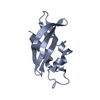 6anwC  6b44C  6b45C  6b46C  6b48C M: このデータのモデリングに利用したマップデータ C: 同じ文献を引用 ( |
|---|---|
| 類似構造データ |
- リンク
リンク
- 集合体
集合体
| 登録構造単位 | 
|
|---|---|
| 1 |
|
- 要素
要素
-CRISPR-associated protein ... , 3種, 8分子 ABCDEFGH
| #1: タンパク質 | 分子量: 49338.297 Da / 分子数: 1 / 由来タイプ: 組換発現 由来: (組換発現)  Pseudomonas aeruginosa (strain UCBPP-PA14) (緑膿菌) Pseudomonas aeruginosa (strain UCBPP-PA14) (緑膿菌)株: UCBPP-PA14 / 遺伝子: csy1, PA14_33330 / 発現宿主:  |
|---|---|
| #2: タンパク質 | 分子量: 36446.352 Da / 分子数: 1 / 由来タイプ: 組換発現 由来: (組換発現)  Pseudomonas aeruginosa (strain UCBPP-PA14) (緑膿菌) Pseudomonas aeruginosa (strain UCBPP-PA14) (緑膿菌)株: UCBPP-PA14 / 遺伝子: csy2, PA14_33320 / プラスミド: pRSF-Duet-SUMO / 発現宿主:  |
| #3: タンパク質 | 分子量: 37781.547 Da / 分子数: 6 / 由来タイプ: 組換発現 由来: (組換発現)  Pseudomonas aeruginosa (strain UCBPP-PA14) (緑膿菌) Pseudomonas aeruginosa (strain UCBPP-PA14) (緑膿菌)株: UCBPP-PA14 / 遺伝子: csy3, csy1-3, PA14_33310 / プラスミド: pCDF-Duet / 発現宿主:  |
-タンパク質 , 2種, 2分子 KL
| #4: タンパク質 | 分子量: 10075.729 Da / 分子数: 1 / 由来タイプ: 組換発現 由来: (組換発現)  Pseudomonas phage D3112 (ファージ) Pseudomonas phage D3112 (ファージ)遺伝子: orf30 / プラスミド: pRSF-Duet-SUMO / 発現宿主:  |
|---|---|
| #5: タンパク質 | 分子量: 21629.777 Da / 分子数: 1 / 由来タイプ: 組換発現 由来: (組換発現)  Pseudomonas aeruginosa (strain UCBPP-PA14) (緑膿菌) Pseudomonas aeruginosa (strain UCBPP-PA14) (緑膿菌)株: UCBPP-PA14 / 遺伝子: cas6f, csy4, PA14_33300 / プラスミド: pACY-Duet / 発現宿主:  参照: UniProt: Q02MM2, 加水分解酵素; エステル加水分解酵素 |
-RNA鎖 , 1種, 1分子 M
| #6: RNA鎖 | 分子量: 19265.404 Da / 分子数: 1 / 由来タイプ: 組換発現 / 由来: (組換発現)   |
|---|
-詳細
| Has protein modification | N |
|---|
-実験情報
-実験
| 実験 | 手法: 電子顕微鏡法 |
|---|---|
| EM実験 | 試料の集合状態: PARTICLE / 3次元再構成法: 単粒子再構成法 |
- 試料調製
試料調製
| 構成要素 | 名称: Type I-F CRISPR crRNA-guided Csy surveillance complex with bound anti-CRISPR protein AcrF2 タイプ: COMPLEX / Entity ID: all / 由来: RECOMBINANT |
|---|---|
| 分子量 | 値: 0.350 MDa / 実験値: NO |
| 由来(天然) | 生物種:  |
| 由来(組換発現) | 生物種:  |
| 緩衝液 | pH: 7.2 詳細: 10 mM HEPES, pH 7.2, 150 mM NaCl, 2nM MgCl2, 1 mM DTT |
| 試料 | 濃度: 0.1 mg/ml / 包埋: NO / シャドウイング: NO / 染色: NO / 凍結: YES |
| 試料支持 | グリッドの材料: COPPER / グリッドのサイズ: 400 divisions/in. |
| 急速凍結 | 凍結剤: ETHANE |
- 電子顕微鏡撮影
電子顕微鏡撮影
| 実験機器 |  モデル: Titan Krios / 画像提供: FEI Company |
|---|---|
| 顕微鏡 | モデル: FEI TITAN KRIOS |
| 電子銃 | 電子線源:  FIELD EMISSION GUN / 加速電圧: 300 kV / 照射モード: FLOOD BEAM FIELD EMISSION GUN / 加速電圧: 300 kV / 照射モード: FLOOD BEAM |
| 電子レンズ | モード: BRIGHT FIELD |
| 試料ホルダ | 試料ホルダーモデル: FEI TITAN KRIOS AUTOGRID HOLDER |
| 撮影 | 平均露光時間: 10 sec. / 電子線照射量: 84 e/Å2 / 検出モード: COUNTING フィルム・検出器のモデル: GATAN K2 SUMMIT (4k x 4k) 実像数: 6237 |
- 解析
解析
| ソフトウェア | 名称: PHENIX / バージョン: 1.12_2829: / 分類: 精密化 | ||||||||||||||||||||||||
|---|---|---|---|---|---|---|---|---|---|---|---|---|---|---|---|---|---|---|---|---|---|---|---|---|---|
| EMソフトウェア | 名称: PHENIX / カテゴリ: モデル精密化 | ||||||||||||||||||||||||
| CTF補正 | タイプ: PHASE FLIPPING AND AMPLITUDE CORRECTION | ||||||||||||||||||||||||
| 対称性 | 点対称性: C1 (非対称) | ||||||||||||||||||||||||
| 3次元再構成 | 解像度: 3.2 Å / 解像度の算出法: FSC 0.143 CUT-OFF / 粒子像の数: 219718 / アルゴリズム: FOURIER SPACE / 対称性のタイプ: POINT | ||||||||||||||||||||||||
| 拘束条件 |
|
 ムービー
ムービー コントローラー
コントローラー




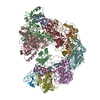
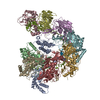
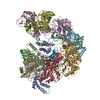





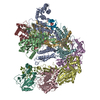
 PDBj
PDBj





























